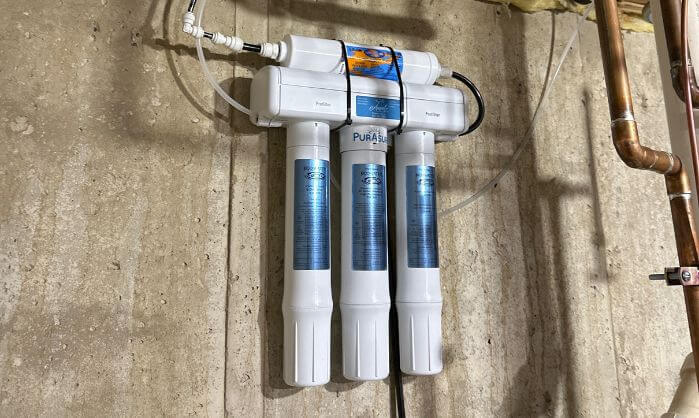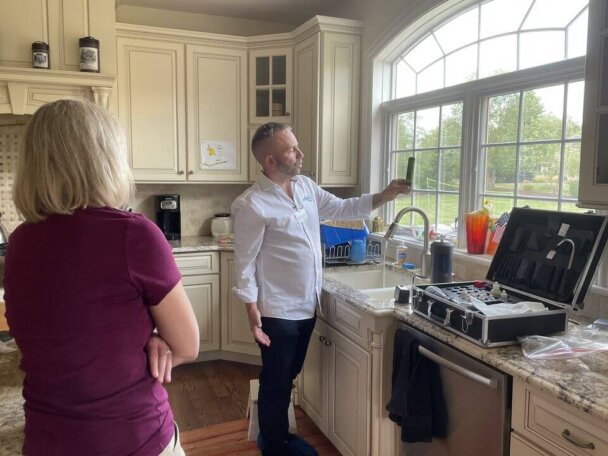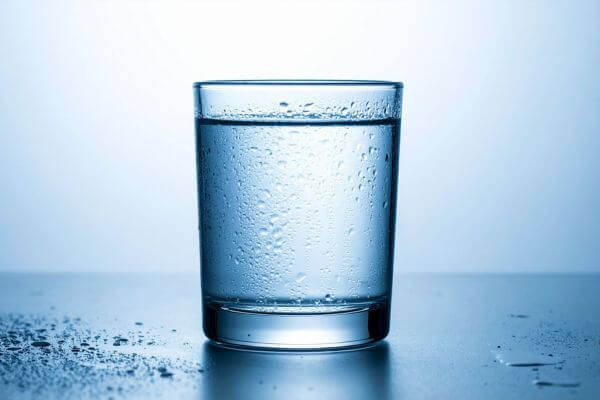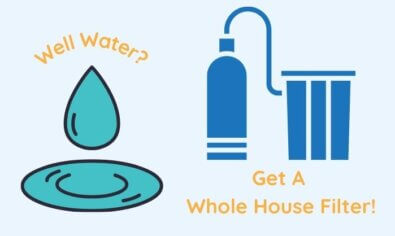How Does a Reverse Osmosis System Work?
How does a reverse osmosis system work to turn contaminated water into clean, pure hydration?
This powerful filtration method uses pressure to force water through a special membrane, removing up to 99% of harmful substances.
Let’s break down how this technology helps millions of homes and businesses access safer water every day:
- Reverse osmosis (RO) cleans water by pushing it through a high-tech filter that blocks dirt, germs, and harmful chemicals.
- The concept of osmosis has been known since the 18th century, but the idea of reverse osmosis didn’t take shape until the 1950s.
- An RO system has several parts: filters to catch dirt, the main cleaning membrane, a tank to store clean water, and a special faucet.
- Reverse osmosis systems make your family’s water taste better and safer to drink.
This article will take you on a step-by-step journey through the science, history, and benefits of this remarkable process.

How Does a Reverse Osmosis System Work?
Basically, reverse osmosis (RO) purifies water by forcing it through a semi-permeable membrane.
Regular filters only trap larger particles. RO systems remove very tiny contaminants. These include heavy metals, pesticides, and other harmful substances.
With pressure, clean water flows through RO’s tiny pores. Meanwhile, impurities get left behind and flushed away.
This process is so effective that the military uses it to make seawater drinkable!
Osmosis and Reverse Osmosis
But to understand RO, you first need to know what osmosis is.
Osmosis is a natural process. It’s where water moves from an area of low concentration to an area of high concentration through a membrane. Of course, this is how plants get water from the soil.
Now flip that process.
In reverse osmosis, pressure is applied to the side with more dirt. As a result, water is pushed from the “dirty” side to the “clean” side. In this way, only clean water goes through.
Consequently, nearly all dissolved substances are filtered out. This leaves behind pure water for you to enjoy.
From Pig Bladders to Pure Water: RO’s History
How reverse osmosis filtration was discovered is interesting. The story begins in 1748.
First, a French scientist used a pig’s bladder to show how water moves through membranes.
Interestingly, the ancient Romans understood a few problems caused by hard water. Therefore, they designed pipes that reduced the amount of particles.
Unfortunately, they did not know how does a reverse osmosis system work.
However, practical reverse osmosis didn’t arrive until 1959. That’s when two UCLA researchers created the first working RO membrane.
By 1965, California opened the first RO plant to help with water shortages. After that, small RO systems became available for the home.
Today, reverse osmosis systems are found in many places. Like in homes, businesses, factories, and even on ships and submarines.
Why Reverse Osmosis Matters
Contaminants are common in tap water. Here are some that RO systems remove:
- Heavy metals like lead, iron, and arsenic
- Chemicals such as PFAS, pesticides, and nitrates
- Radioactive particles
- Microorganisms like bacteria and viruses
- Asbestos fibers
- Sediment: Sand, clay, and other particles
In fact, RO systems work amazingly. That’s because their membranes trap items as small as 0.0001 microns. That’s many times thinner than human hair!
How Do RO Filters Work? The Magic Revealed
A typical home RO system uses several stages of filtration. This is to purify water thoroughly.
Here’s how the process really works:
Sediment filter: First, water goes through a sediment filter. This removes large particles like sand, silt, and rust. Otherwise, these can clog later filters. Or hurt the RO membrane.
Carbon filter(s): Next, the water passes through at least one carbon filter. These filters remove chemicals and organic compounds.
Additionally, they improve the taste and smell of water. Often, there are two carbon filters: one to protect the RO membrane and another to improve taste.
Reverse osmosis membrane: Then, water flows to the heart of the RO system. The RO membrane has tiny pores that allow water to flow through.
However, they block over 99% of dissolved material. Pressure pushes the water across this barrier.
Post-carbon filter: After that, it passes through a final carbon filter. This step removes any remaining tastes or odors. Therefore, you can enjoy fresh, pure water.
Storage tank: Finally, the purified water flows into a storage tank. This ensures you always have clean water ready when you need it.
Dedicated faucet: Most RO systems include a separate faucet. It’s installed on your sink. Then, this faucet dispenses purified water.
What Happens to Wastewater?
Not all water entering the system becomes purified. As a matter of fact, some water is used to flush away debris.
This wastewater usually goes down the drain. Notably, the amount of waste depends on the system. Fortunately, newer systems are more efficient.
You may be concerned about waste. Collect this “gray water” for gardening or cleaning. In this way, you can help conserve more water.
How Does a Reverse Osmosis System Work in Other Applications?
RO systems aren’t just for homes. In fact, they’re important for many industries.
Residential: Under-sink RO systems are great. They give your loved ones the best drinking water. Furthermore, some homes use whole-house RO systems for more access.
Unsure About Your Water Quality? Get a Free Water Test Today!
Contaminants can affect the safety and taste of your water. Get a free water test to check your water quality and see if a reverse osmosis system can help provide clean, pure drinking water.

Commercial: Because it works so well, businesses like cafes, coffee shops, and pubs rely on RO systems. They ensure high-quality water for their products.
Industrial: Many industries, including electronics and power generation, require ultra-pure water for their processes. Hence, RO systems are needed for meeting tough quality standards.
Desalination: Large-scale RO plants are crucial. Particularly for many dry and coastal regions. They change seawater into drinkable water. Thus, this helps address water scarcity issues.
Agriculture: In some cases, RO systems are used to purify irrigation water. For this reason, clean water improves crops. Also, it reduces the buildup of fertilizers in soil.
Emergency use: Portable RO units provide safe drinking water. This is needed in disaster zones and during emergencies. These systems can be lifesaving. In fact, when clean water is scarce, they’re a must-have.
RO improves the quality and safety of your drinking water. It effectively filters out unwanted chemicals. Therefore, it’s vital tech for everyone.
How Does a Reverse Osmosis System Work to Improve Your Life?
Now we understand the complete process. So, let’s explore the many benefits of an RO system.
Here’s what you can expect:
Cleaner, Healthier Water
- First, it filters up to 99% of harmful substances
- Then it removes unpleasant tastes and odors
- Lastly, RO delivers consistently clear, fresh water
Health Protection
- Reduces exposure to contaminants that may cause illness
- Supports people with weakened immune systems
- Pure water for cooking, baby formula, and more
Cost and Environmental Benefits
- Cuts down on bottled water purchases
- Reduces plastic waste
- Saves money and time
Better-Tasting Food and Drinks
- Coffee and tea taste better
- Enjoy clearer ice cubes
- RO water improves pasta, soup, rice, and vegetables
It’s easy to see why many property owners change to RO. Indeed, now you know the benefits, you’ll want one too!

Frequently Asked Questions About Reverse Osmosis
Q: How does a reverse osmosis system work differently from a regular water filter?
A: Traditional filters mostly remove chlorine and some particles.
In contrast, RO systems go a lot further. They remove almost all unwanted material.
Q: Do RO filters remove healthy minerals?
A: Yes, reverse osmosis removes most minerals. Ones both bad and good. However, many systems include remineralization. In effect, this adds back calcium as well as many benefits.
Q: How often do I need to replace the filters in an RO system?
A: It varies by system and usage:
- Sediment and carbon filters: Every 6–12 months
- RO membrane: Every 2–3 years
- Post-carbon filter: Every 6–12 months
Accordingly, regular maintenance by Angel Water’s licensed plumbers ensures peak performance and water quality.
Q: Does a reverse osmosis system waste water?
A: Yes, some wastewater is created. But modern systems are more efficient than older ones.
Q: Can I use RO water for pets or plants?
A: Yes, RO water is safe for pets. However, some gardeners prefer to use water with natural minerals.
Final Thoughts: How Does a Reverse Osmosis System Work for You?
Now you know the answer to “how does a reverse osmosis system work.”
Simply, it’s easy to see why RO is trusted worldwide. Because it’s a simple yet powerful process. And you get clean, safe, and great-tasting water.
An RO system is a smart investment. They’re great for your home or business. Especially if you’re concerned about your tap water. Or just want better-tasting food and drinks.
Do you need help choosing the right reverse osmosis system for your home or business?
Now that you understand how a reverse osmosis system works, you can see why so many people trust it to deliver cleaner, safer water.
Need help choosing the right reverse osmosis system for your home or business? Contact the expert team at Angel Water for expert guidance and free water testing!
Ready for Cleaner Water? Schedule an Appointment Now!
Ensure your family has access to clean, great-tasting water. Schedule an appointment with our specialists today to learn how a reverse osmosis system can purify your drinking water.



